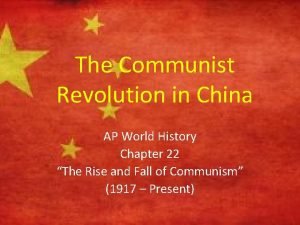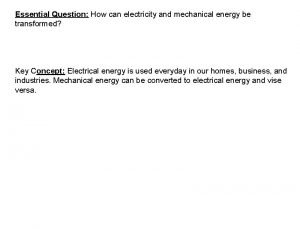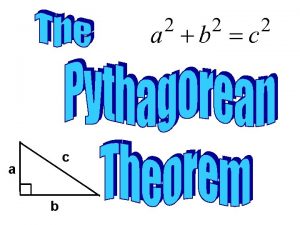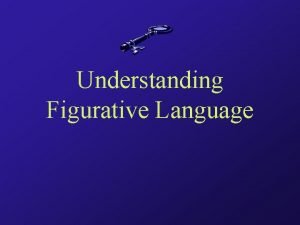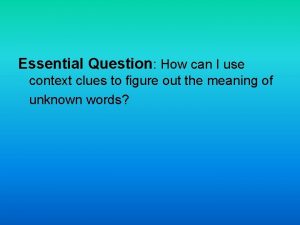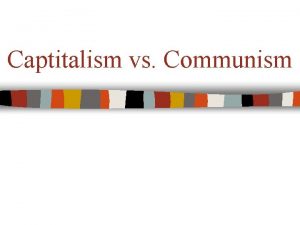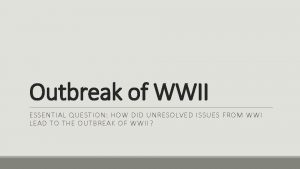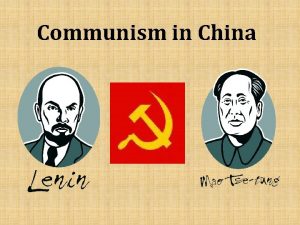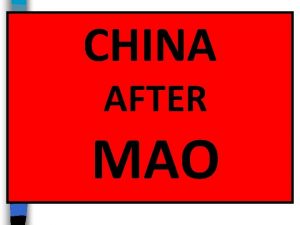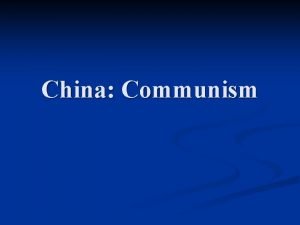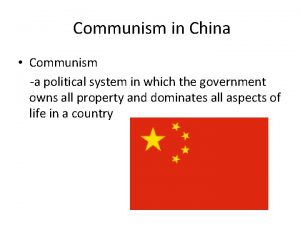Communism in China ESSENTIAL QUESTION HOW DID UNRESOLVED










- Slides: 10

Communism in China ESSENTIAL QUESTION: HOW DID UNRESOLVED ISSUES FROM WWII LEAD TO COLD WAR TENSIONS?

TEKS and Objectives WE WILL… I WILL… (13 B) summarize the factors that contributed to Communism in China, including Mao Zedong’s role in its rise, and how it differed from Soviet Communism Evaluate the leadership of Mao Zedong (21 A) describe how people have participated in supporting or changing their governments (22 C) identify examples of politically motivated mass murders in China

Communist Revolution in China Mao Zedong ◦ Leader of Communist rebels Long March (1934 -1937) ◦ Zedong retreated from northwestern China

Communist Revolution in China Japanese Invasion (1937) ◦ Nationalists and Communists joined forces against Japan ◦ Fighting resumed after WWII Communism Wins ◦ Nationalist government fled to Taiwan ◦ Consider themselves the true Chinese government

Changes to China Under Mao Elimination of “Capitalist Class” ◦ Landowners, factory-owners, village leaders, better-off peasants ◦ At least one million “capitalists” killed Reeducation ◦ Communism became required learning in schools ◦ Newspapers/books controlled by government ◦ Art/Music supervised by government

Changes to China Under Mao The Family ◦ Children taught to obey state, not parents ◦ Ancestor worship forbidden ◦ Weakened the father’s traditional role as leader

The “Great Leap Forward” Farmers ◦ Forced into communes (cooperative farms) ◦ Families shared work/divided crops Five-Year Plan ◦ Plan for industrialization of China ◦ Population used to build dams, roads, and factories ◦ Led to starvation and economic crisis

China’s Cultural Revolution ◦ Mao’s movement to revitalize Communism in China ◦ “Little Red Book” contained Mao’s sayings about Communism Red Guards ◦ 11 million university students ◦ Traveled through China ◦ attacked writers, scientists, doctors, professors, factory managers, and party officials

China’s Cultural Revolution Results of Cultural Revolution ◦ Scholars/professionals sent to work in fields ◦ Artworks from Dynastic China destroyed ◦ Many imprisoned, tortured, and killed ◦ Shortages of food/goods

Journal Entry #37 Mao in China achieved tremendous economic and social changes in their countries, but at a terrible cost. What is your evaluation of this leader? Give at least 2 specific examples to support your answer.
 Chinese communist party ap world history
Chinese communist party ap world history Levels of questioning examples
Levels of questioning examples Essential non essential fatty acids
Essential non essential fatty acids Essential questions for figurative language
Essential questions for figurative language Formula hipotenusa triangle rectangle
Formula hipotenusa triangle rectangle Essential question generator
Essential question generator Essential questions for pythagorean theorem
Essential questions for pythagorean theorem Figurative language essential questions
Figurative language essential questions Individual vs society
Individual vs society Essential questions for context clues
Essential questions for context clues What is the essential question in cornell notes
What is the essential question in cornell notes
